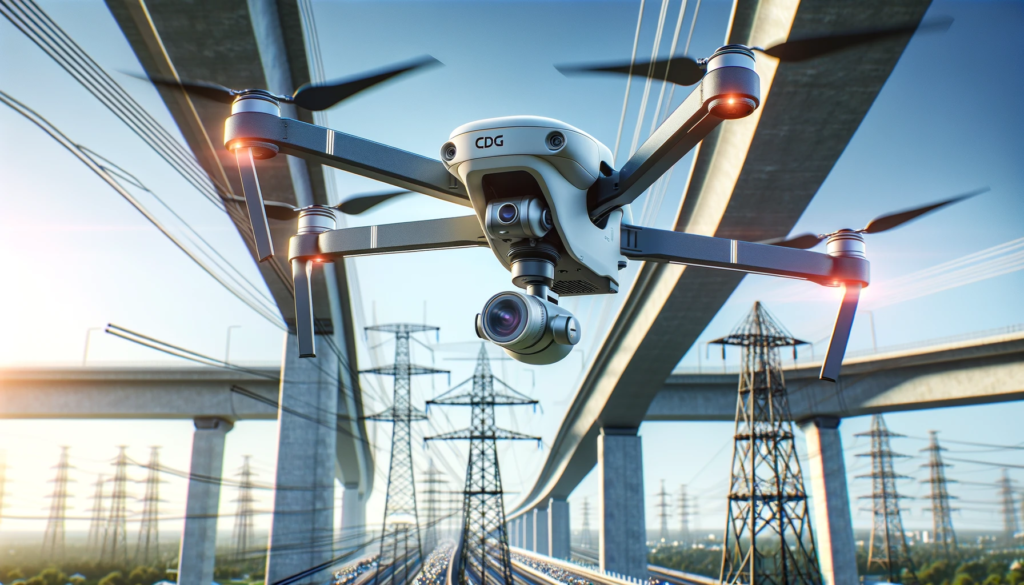Introduction
In the realm of utility management and safety, innovation is not just a luxury but a necessity. The advent of drone technology has marked a significant leap forward, particularly in the context of power line inspections. At CDG, a leading inspection agency, we’ve integrated drone technology to revolutionize how power line safety inspections are conducted. This blog post delves into the intricacies of drone-based power line safety inspections, showcasing how this cutting-edge technology is setting new safety standards, enhancing efficiency, and reducing risks.
What is Drone Power Line Safety Inspection?
Drone Power Line Safety Inspection refers to the use of unmanned aerial vehicles (UAVs), or drones, to visually and thermally inspect high-voltage power lines. This method is a transformative shift from the traditional manual inspections, which involve physical presence on the lines or the use of helicopters. Drones equipped with high-resolution cameras and thermal imaging offer a detailed view of the power lines, enabling inspectors to identify issues such as overheating joints, corrosion, and wear and tear on cables and insulators.
Why Use Drones for Power Line Inspections?
Enhanced Safety
One of the most compelling reasons to use drones for power line inspections is the significant increase in safety. Traditional methods require linemen to physically climb poles or utilize helicopters, both of which pose substantial risks. Drones eliminate the need for human presence at dangerous heights and proximities to high-voltage lines, thereby reducing the risk of accidents and enhancing overall safety.
Cost Efficiency
Using drones for power line inspections reduces the need for expensive helicopter flights and minimizes the labor-intensive aspects of manual inspections. This can result in substantial cost savings for utility companies, as drones can cover extensive areas quickly and efficiently, with less downtime and fewer resources.
Improved Accuracy and Detail
Drones capture high-quality images and generate real-time data that can be more accurate than what is obtainable through manual inspections. Equipped with advanced imaging technologies, drones provide detailed visual insights and detect minute defects or potential issues that might be overlooked by the human eye.
Minimal Interruption
Drones operate with minimal disruption to the surrounding environment and the power supply itself. Unlike traditional methods, which may require shutting down sections of the grid, drone inspections can be performed without interrupting the power supply, ensuring that consumers face no inconvenience.
How Does Drone Power Line Inspection Work?
The process of drone power line inspection involves several key steps:
Pre-Flight Planning: Before the flight, inspection routes are carefully planned, and drones are equipped with necessary imaging tools. This stage involves setting the GPS coordinates and ensuring all safety checks are in place.
Flight Execution: Drones are piloted along the predetermined routes. They capture video and images, and thermal sensors collect data on the condition of the power lines and associated infrastructure.
Data Analysis: The data collected by the drones is analyzed using advanced software that can detect abnormalities like hotspots indicating potential failures. This software can integrate AI to enhance the detection accuracy.
Reporting: Detailed reports are generated based on the analysis, highlighting any issues and recommending corrective actions. These reports are crucial for maintenance teams to prioritize and address issues promptly.
Case Studies and Success Stories
At CDG, we’ve successfully implemented drone technology across various regions, improving the safety and efficiency of power line inspections. For instance, in a recent project in a densely populated urban area, our drone inspection identified multiple potential hazards across several miles of lines, which were previously undetected by traditional inspections. The prompt identification and rectification of these issues prevented potential outages and hazards.
The Future of Drone Inspections
The integration of drones in power line inspections is just the beginning. As drone technology advances, we anticipate more sophisticated sensors and AI algorithms that will further enhance the accuracy and efficiency of inspections. Additionally, regulatory frameworks are evolving to support the safe and effective use of drones in utility inspections.
Conclusion
The use of drone technology in power line safety inspections represents a significant advancement in the field of utility management. At CDG, we are proud to be at the forefront of this innovation, leveraging cutting-edge technology to ensure safety, reduce costs, and improve the reliability of power supply systems. As we continue to explore and expand the capabilities of drone technology, the future of power line inspections looks not only promising but revolutionary.
